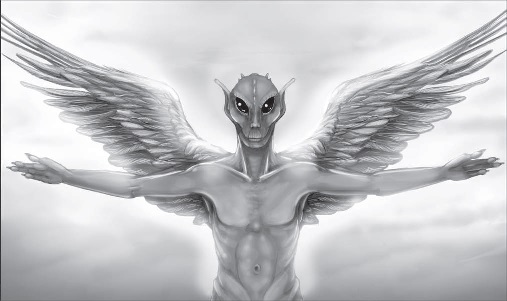Aletheia by GimpInBlack
Intro: If Walter Bishop ran the Planetary Foundation
Original SA post
At some point I really should finish my Night's Black Agents writeup, but fuck if there's not a ton of dry, fiddly rules stuff to work through before I get to the cool stuff. So in the meantime, let's take a look at a pretty neat and not very well known game from 2007. A game about weird Forteana, mysterious abilities, and all the ayahuasca tea you can drink.
If Walter Bishop ran the Planetary Foundation, the results might look a little bit like...
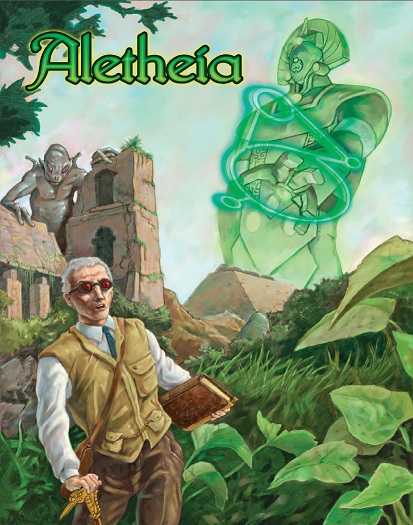
I'm not Daredevil!
Published by Abstract Nova Entertainment, creators of such high-concept RPGs as Heaven & Earth, Noumenon, and Exquisite Replicas,
Aletheia
describees itself as a game of big questions: how did the universe begin? Where do we come from? Where are we going? The title is a Greek word that variously translates as "unconcealedness," "disclosure," or "truth," so you know we're about to get all existential up in here.
Still, despite having a pitch rife with potential for sinking into pseudo-philosophical wankery,
Aletheia
by and large manages to sidestep the pitfalls of games like The Everlasting and Immortal: The Invisible war and present a pretty neat, pretty coherent world of modern "weird fiction" that unabashedly wears the influence of authors like Warren Ellis, Grant Morrison, and Arthur C. Clarke on its sleeve. Married to a solid if not hugely ground-breaking rules-lite engine that has shades of GUMSHOE and
Over the Edge,
it's easy to get into and does a great job of easing you from typical X-Files fare like alien abductions and spontaneous human combustion into full-on
 territory.
territory.
It's also a very tightly-focused game: while you could use it to run a completely procedural "weird event of the week" type game with no overarching story, the entire setting is really built around telling one specific story of discovery and enlightenment... but we'll get to that.
All right, let's get this started. I'm going to try to cover two chapters per post for at least the first 3 or 4 chapters, but might end up going down to one per post when we get into the meatier setting stuff.
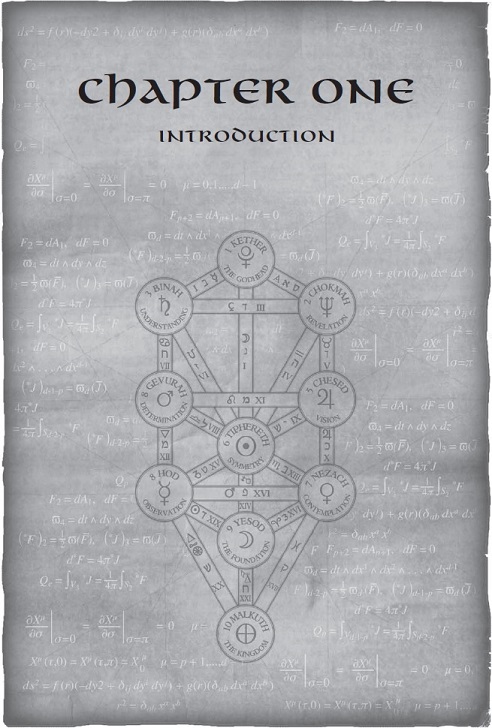
Albert Einstein posted:
All religions, arts, and sciences are branches of the same tree. All these aspirations are directed toward ennobling man’s life, lifting it from the sphere of mere physical existence and leading the individual towards freedom.
Between the image of the Tree of Life superimposed on a bunch of mathematical equations and that opening quote, Aletheia is pretty up front about its central themes. Expect a lot of Biblical apocrypha and quantum physics ahead.
In the meantime, we get a very brief summary of what the game is actually about: PCs are members of the "Seven Dogs Society," a group of scientists, philosophers, and investigators who look into strange, inexplicable events like hauntings, crop circles, and extraterrestrial incursions. The Society isn't a paramilitary group, they don't fight or hunt the bizarre. Rather, they believe that an underlying, fundamental truth explains and unifies all of these so-called paranormal events, and that by cataloguing and studying the extra-normal, they can bring themselves closer to that truth and to a greater understanding of the nature of reality itself. If you're getting a bit of a Fringe vibe... well, that's a coincidence, because that show didn't start airing till 2008, but you wouldn't be far off. We're not told much else about the Society for now; only that it's very wealthy thanks to "a generous benefactor" and that it's very small: as the name implies, the Seven Dogs Society always numbers exactly seven.
GMs get a brief discussion of the sorts of game Aletheia can be used to run. Its investigative focus makes it ideal for one-shots: just open with the Society receiving a report of an alien abduction and wrap up when the mystery is solved, just like a monster of the week episode of The X-Files . We're also assured that everything about Aletheia's setting is explained in this core book, which means the GM is in on all the game's secrets from the get-go and doesn't have to read a bunch of supplements to get the full story. That makes it easy to plan out a self-contained campaign beginning with the PCs' induction into the Seven Dogs Society and ending when they REDACTED REDACTED REDACTED REDACTED . Finally, you can pull a Brian Michael Bendis and decompress the hell out of the storytelling, expanding the full reveal out over multiple campaigns, presumably featuring a succession of new Seven Dogs Societies--which I guess would look a bit like the various Leagues of Extraordinary Gentlemen, but the Introduction doesn't go into any more detail than that.
The Introduction wraps up with a quick overview of what's in the rest of the book, the obligatory What Is Roleplaying? sidebar, and a caveat that the game delves into sensitive topics like religion and drug use, and that players who are bothered by that sort of content should stop reading now. Apparently it's fine to play a game with content that might offend you, but for heaven's sake don't read it.
Forthcoming Chapters
-
Chapter Two: History
discusses the origin of the Seven Dogs Society. Shockingly, it's not an ancient, vast conspiracy stretching back to the dawn of history.
-
Chapter Three: Hepta Sophistai
is a detailed description of the Society's home base, an old Victorian mansion in the town of Seven Dogs, Alaska. Because every paranormal investigator should know where his butler sleeps.
-
Chapter Four: Characters
continues the glorious RPG tradition of telling you how to make a character before telling you how to play the damn game.
-
Chapter Five: Mechanics
tells us how many dice to roll when analyzing the meteorological effects of a rain of frogs.
-
Chapter Six: Anomalous Phenomena
catalogues a wide cross-section of the types of cases the Society commonly investigates. Spoiler alert: Abduction, UFO cross-references with Birth, Virgin.
-
Chapter Seven: Revelations
takes the GM up onto the mountain, doses her to the gills with peyote, and explains, like, the real truth of the universe, maaaaaan.
-
Chapter Eight: Gamemastering
includes a picture of a kangaroo.
-
Finally,
Chapter Nine: From the Heavens
is a sample adventure about UFO abductions at Kansas State University. I don't really even have a joke for that.
A final note before we dive into the meat of the game: Since Aletheia is pretty light on images and walls of text can be tedious, I'll probably be supplementing these posts with photos and drawings pertinent* to the text of the review.
* "Pertinent" can sometimes mean "tangentially related at best."

The Seven Dogs Society was founded by Terrance Chastain in 1970, but the Societies' beginnings go back several decades before that. Yes, this is the first time we've heard the name Terrance Chastain, and yes, the book is just that matter of fact about it. Anyways, we're told that the legacy of the Seven Dogs Society begins with a man named Jericho Usher.

Wrong Jericho.
Usher was born in Boston on January 9, 1900, missing century baby status by eight lousy days but nevertheless demonstrating remarkable abilities by a young age. Violin virtuoso, polymath, and gifted athlete, Usher was hailed as a wünderkind, a 20th century Leonardo da Vinci. The world was at his feet--until, in 1922, he was diagnosed with Stargardt disease , an inherited form of macular degeneration that gradually destroyed his vision. Along with the Stardart's, Usher found himself suffering from Charles Bonnet syndrome , which left him suffering from visual hallucinations so vivid he feared he was going mad. (Spoiler alert: he wasn't. )
Shortly thereafter, Usher befriended Charles Fort , the paranormal researcher, and became an admirer of his work. This led to two decades of ostracism from the scientific community, during which time Usher read basically everything he could get his hands on, knowing that soon the written word would be lost to him.

In '46, Usher befriended Terrance Chastain, who we finally learn is an archaeologist specializing in Mesoamerican cultures. The two spent the next three years on various digs, "somehow" returning to the US fabulously wealthy. Indiana Jones would have been appalled. They bought land in the tiny Alaskan town of Seven Dogs and renovated an old Victorian mansion into a truly impressive research library. To further cement his Forrest Gump-like status, Usher struck up a correspondence with Einstein and talked a lot about the Unified Field Theory.
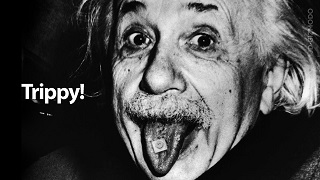
This will become relevant soon.
So, by the 1960s, Usher was completely blind and also in full on
 mode. Experimenting with everything from DMT to psilocybin, he became convinced that his hallucinations were anything but. He believed he was actually seeing another level of reality he called the Otherverse, because drugs do not make you good at naming things. He would disappear for days or weeks on end, only to reappear walking out of a random room like nothing had happened. He talked a lot about how his Charles Bonnet syndrome, Forteana, and Einstein's Unified Field Theory were just pieces of a bigger picture, started making radical architectural modifications to the werstern annex of Seven Dogs House, and made Chastain promise never to go in there. Finally, in December of 1968, Usher left Chastain a single sheet of handwritten instructions, a ream of genealogical studies on looseleaf paper, and about 50 pages of ancient vellum covered in bizarre writing and drawings. Then he vanished without a trace, never to be seen again.
mode. Experimenting with everything from DMT to psilocybin, he became convinced that his hallucinations were anything but. He believed he was actually seeing another level of reality he called the Otherverse, because drugs do not make you good at naming things. He would disappear for days or weeks on end, only to reappear walking out of a random room like nothing had happened. He talked a lot about how his Charles Bonnet syndrome, Forteana, and Einstein's Unified Field Theory were just pieces of a bigger picture, started making radical architectural modifications to the werstern annex of Seven Dogs House, and made Chastain promise never to go in there. Finally, in December of 1968, Usher left Chastain a single sheet of handwritten instructions, a ream of genealogical studies on looseleaf paper, and about 50 pages of ancient vellum covered in bizarre writing and drawings. Then he vanished without a trace, never to be seen again.
Now, as you might expect, Chastain was pretty much humoring his blind crazy friend for most of the 60s, and didn't really have any intention of following through on any of the crazy instructions Usher had left him. Then he decided to go and see exactly what Usher had been doing in the Annex. It was a simple enough bit of architecture: just a short hallway with nine doors off of it. Thing is, those nine doors didn't lead to rooms in the house. One led to an archaeological dig site in a desert. Another opened onto a jungle. Others opened onto strange libraries, Mayan ruins, and weirdly, a junkyard outside Taos, New Mexico. The portals were all one-way and led to places all over the world.
About then was when Chastain decided to follow Usher's instructions. Usher wanted Chastain to found a society to carry on his work: the society would always number seven, and prospective members had to come from the genealogies Usher had left behind. Said genealogies sometimes went as far back as 150 BCE--and as far forward as 2012 CE. In case that wasn't enough weirdness, radiocarbon dating confirmed that the vellum pages Usher left Chastain--the so-called Usher Codex --dated to the mid-15th century, but the handwriting and art style was unmistakably Jericho Usher's.
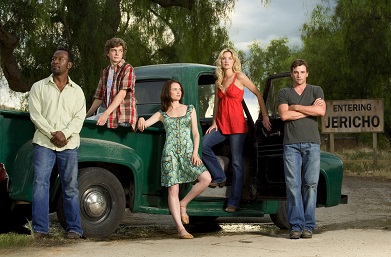
Nope. Still not the right one.
After two years of investigation and interviews, Chastain assembled the first incarnation of the Seven Dogs Society in 1971. Once they were all together, the purpose of Usher's genealogies became apparent: every one of the seven possessed a paranormal ability of some kind, from ESP to remote viewing to the ability to walk through solid objects. These seven spent almost 30 years together, investigating paranormal phenomena and working to decipher the Usher Codex . (At least, what they had of it: a fire in the early years of the society destroyed all but four pages, though a fifth was recovered from the Bibliothèque nationale de France in 1984. Nobody knows how it got there.) Finally, in 1999, they all disappeared, just like Usher had 31 years ago.
Displaying remarkable patience and forbearance for a man dealing with super-powered ghost chasers with a penchant for disappearing, Chastain assembled a second incarnation of the Seven Dogs Society in 2001. Less than a year later, while walking the Annex, Chastain discovered the bodies of all seven members, left to rot in the jungles of South America in plain view of the portal. The portal that, you'll remember, is only one-way and can't be seen from the other side. Once the bodies were recovered, the autopsies revealed that each had been shot in the head, execution style.
Which brings us to the present day (well, 2007, but "present" for the game). Chastain has finally assembled the third incarnation of the Seven Dogs Society. It's very likely this will be the last: Chastain is 83 years old and doesn't have it in him to go through the recruitment process again. The PCs make up some (maybe all, if you have a big table) of this incarnation of the Society. They've been members of the society for about a month, and their first case is coming up. It's time to learn the truth Jericho Usher found.
Thoughts so far: I really like this approach to opening a game book. It draws you in without bogging you down in world-building minutiae, presents a few really good, strong central mysteries to hook you into the setting, and actually tells you what the game is about without spoiling the big secrets of the setting. I also like that the History chapter includes a sidebar talking about the advantages of letting the players just read the whole chapter as a primer vs. giving them a brief outline (ostensibly in-character as Chastain). Personally, I'd probably go the latter route and ignore the "you've been a member for a month" caveat--the reveal of the Annex and its portals has a ton of potential, and I don't think I'd be able to resist holding back the second incarnation's fate until after somebody tries to kill the PCs during the first adventure.
Next Time: Twenty pages about a house. It actually manages to be kind of interesting.
Seven Dogs, Alaska
Original SA post
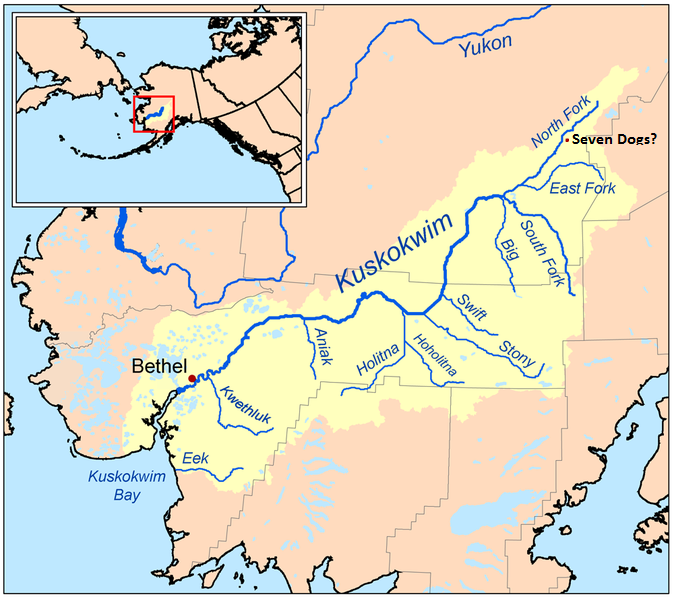

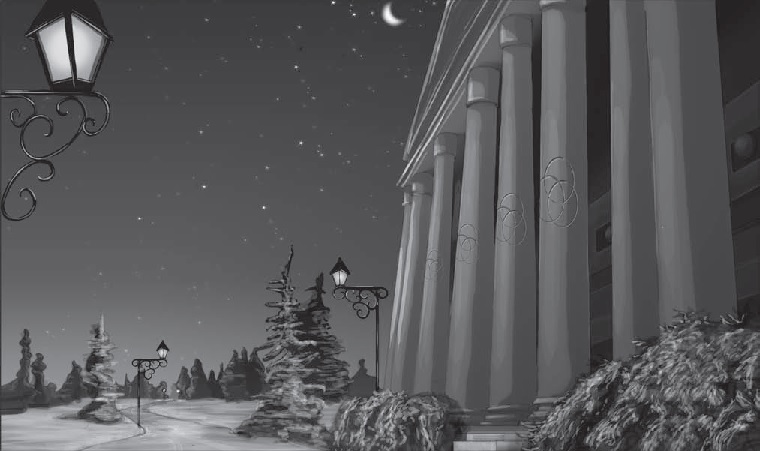
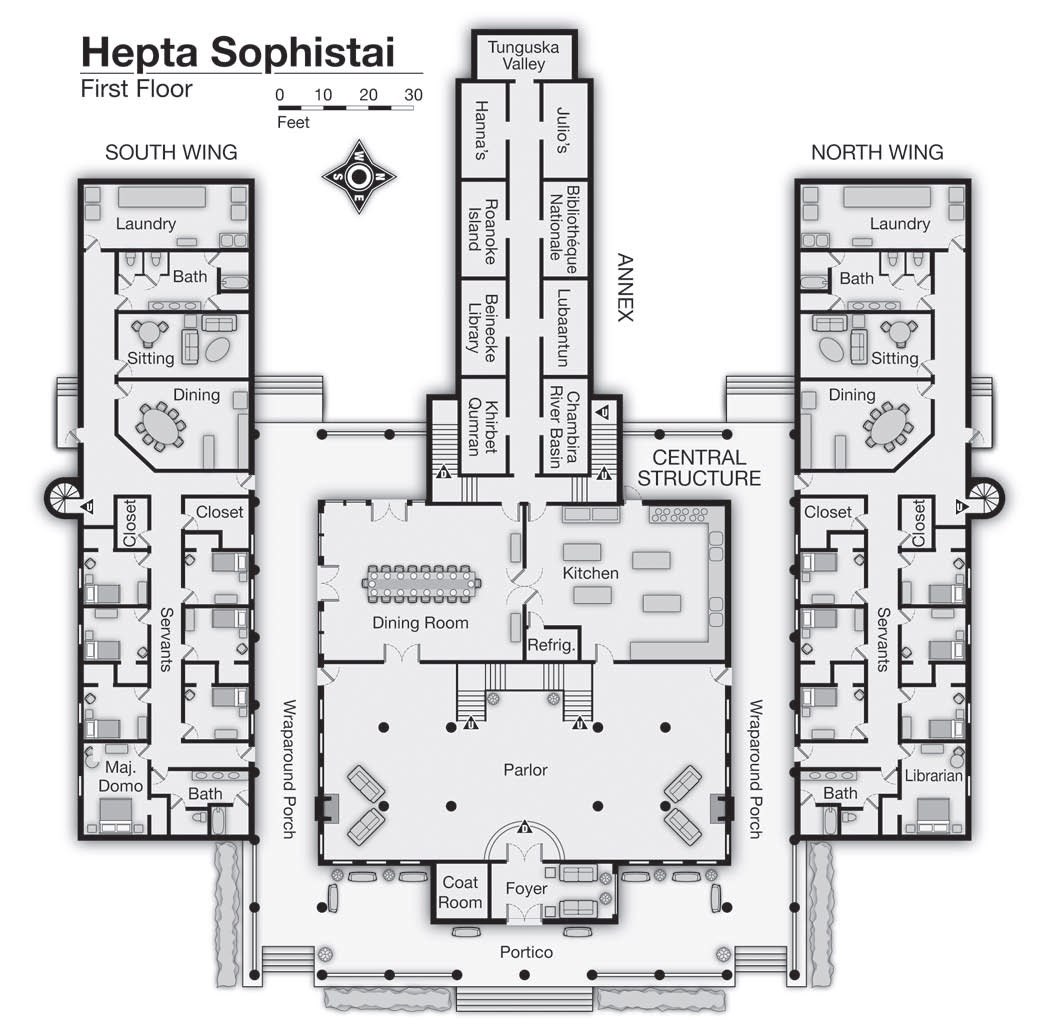
-
The wings are detached on the first floor, but directly connected on the second, which makes for plenty of odd nooks and tunnels running between the two.

-
We're told that "entering from the west," we're likely to be met by the butler in the parlor. That's either a crazy space warp or a typo, because the parlor is on the east side of the house.
-
The butler insists that his name is "Jeffrey," despite being clearly and obviously a Russian expat.
-
The parlor floor is marble and features bas-relief carvings from the Iliad and the Odyssey, which strikes me as a tripping hazard but what do I know?
-
Also in the parlor: Works by Picasso, Braque, and Escher, plus a frieze described as "a variation of the Bayeaux Tapestry carved in full relief by the surrealist sculptor Marcel Duchamp."

-
The stairs up off the back of the kitchen go nowhere. They "rise 4 steps to a landing, turn left and climb 11 steps, turn left, and rise a final seven steps before ending at an empty wall. From the outside, this stairwell would appear to lead high up into the vaulted ceiling of the annex, but the original purpose or plan for the stairwell is unknown."

-
The second floor is primarily given over to the library and to living quarters for the society members. I imagine the campaign beginning with a fight over who gets the central apartment right off the library with the private bath.
-
The library is mostly stocked with texts on science, history, philosophy and the paranormal, but thanks to previous Society members' personal tastes "the library has collections from a variety of science fiction and fantasy authors, a large number of forties pulp magazines, and the largest collection of manga in Alaska." Just in case you had any doubt that this chapter is the authors building their nerd dream house.
-
Lots of windows and natural light for a place that stores a bunch of ancient books, don't you think?
-
No actual mention of where the five surviving pages of the
Usher Codex
are stored. You'd think they'd at least keep them in a fireproof safe after what happened last time. But hey, no reason we need to know where the one-of-a-kind, absolutely vital to enlightenment documents are. Tell me more about them animes.
-
Given that the house was purpose-built for the Seven Dogs Society, having two studies that can seat 10 people each seems like overkill.
-
Notes from 2007: All the workstations are explicitly described as "wired to the internal network." Also there are computer workstations. Nowadays I imagine you're issued a Seven Dogs Society official tablet with wi-fi access.
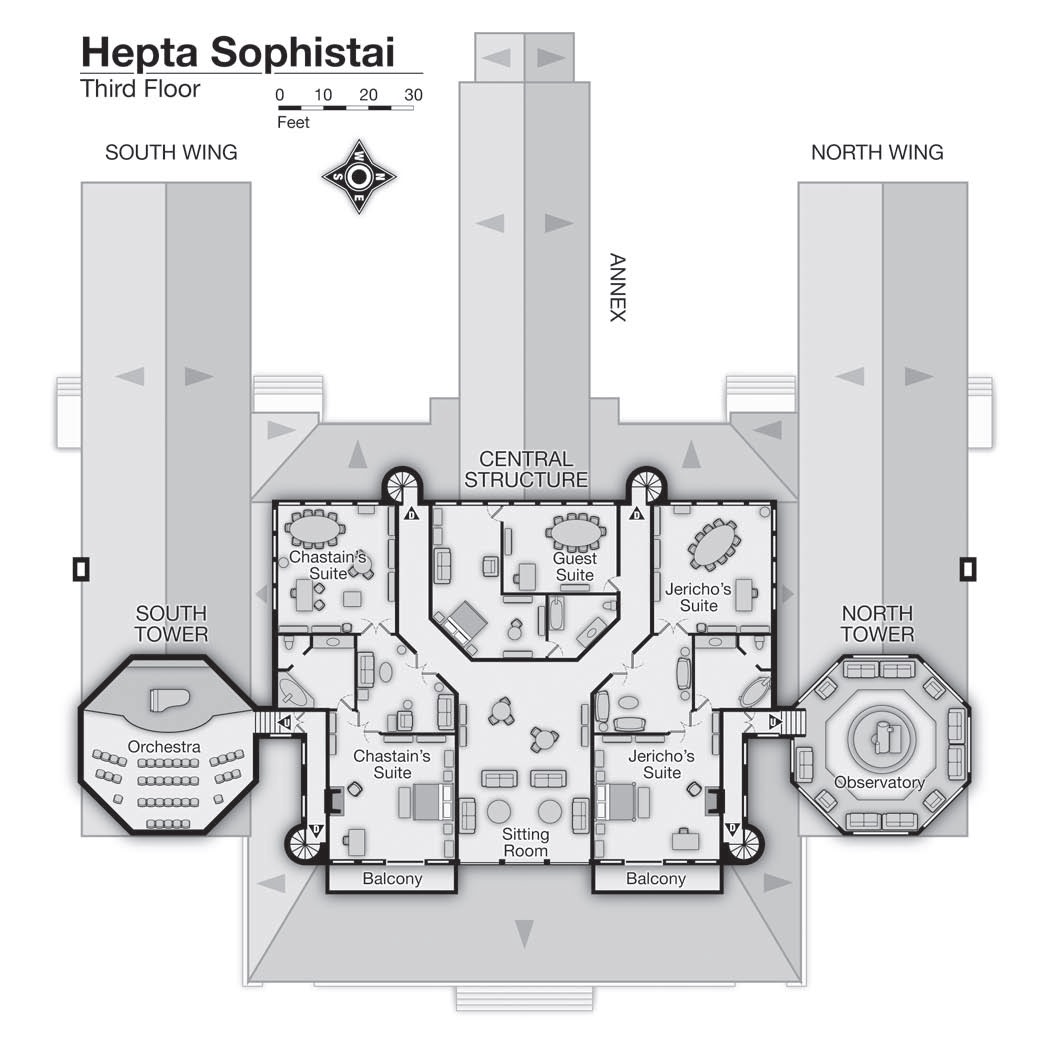
-
The third floor is mostly given over to Chastain's and Usher's living quarters. Chastain's are eternally cluttered with piles of books and ancient artifacts, but the old man always seems to know exactly where everything is.
-
Usher's rooms are kept locked up tight, but if the PCs break in (and you know they will), they'll find that it's impeccably organized and catalogued. Despite the fact that the thick layer of dust on everything shows no sign of having been disturbed in decades, perusing the shelves with reveal quite a few books published after Usher disappeared.
-
If the giant Orchestra Room in the south tower doesn't immediately make you want to run a story about a musical instrument that induces crazy visions, I don't know what to tell you.


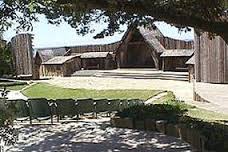




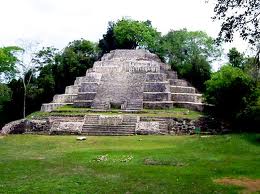

The League of Infringing Gentlemen
Original SA post
The wife's at rehearsal all evening and I've got nothing better to do than write some more about...

"No, Steve. I
didn't
see that. Asshole."

Before going into character creation, a short detour into Chapter Five. You see,
Aletheia
commits that layout sin so common to RPGs: telling you how to make a character before it tells you how to play the game. Since that's annoying as hell, we're going to take a minute to talk about the basic task resolution mechanic first.
Aletheia
uses a straightforward d6-based dice pool system for task resolution: The GM sets a
target number
from 1 ("For actions routinely done with ease by mildly trained individuals.") to 7 ("For extraordinary actions rarely done by highly trained individuals.") and you roll some dice determined by your character's
Attributes
(usually between one and six). Any dice that come up 5s or 6s are considered
victories.
(The game text consistently italicizes all these terms, which I admit makes them pop on a quick skim better than just capitalization.) If your
victories
equal or exceed the
target number
, you succeed. If not, you don't. Other aspects of your character's stats can give you extra dice to roll or even free
victories
to help you hit those higher TNs.
And that's... it. We don't get any more detailed discussion of how to gauge appropriate TNs than that. No discussion of shifting TNs based on mitigating circumstances. We get two examples, but they literally only tell us that the
target number
of picking a lock is 2 and the TN for first aid is 1, with no justification at all. No critical success or failure systems. Not even a general rule for acting in opposition to another character. I like a rules-light system as much as the next guy, and granted a lot of this stuff is intuitive if you're an experienced GM, but it seems to me this section could have used a little more love. Maybe shave a few pages about the dinnerware hutches from the last chapter.
Now, back to character creation. Assisting us in our character creation process are the following completely fictional and most assuredly not-at-all-real characters:
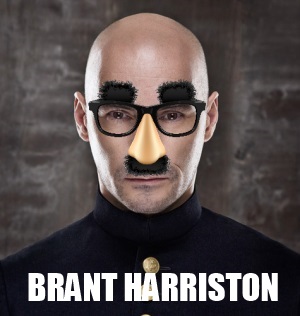


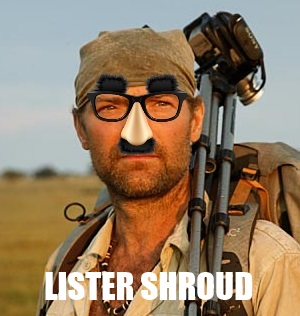
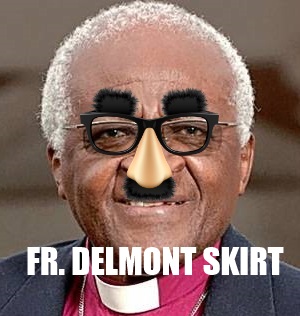
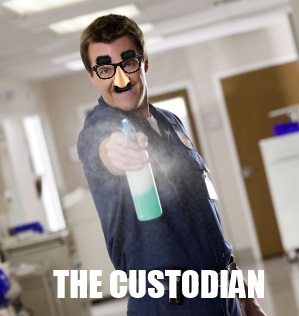
Pictured: FICTIONAL CHARACTERS
For once we get a chapter with some actual introductory text! It's a fairly standard three paragraphs about how roleplaying is interactive storytelling and the PCs are your way to interact with the world, PCs should be dynamic, interesting, and three-dimensional, and how in game terms they're defined by a series of traits, but still, it's an intro. We then get a reiteration of the basic high-concept pitch: PCs were recruited about a month ago to the Seven Dogs Society. Members can come from any background or walk of life, but backgrounds in religion, philosophy, science, or investigative work are especially valuable. Having been around for a month, the PCs are assumed to have met the other Society members, gotten familiar with
Hepta Sophistai
(including the Annex), and have access to the pages of the
Usher Codex
. However, they probably don't know a huge deal about each other. Oh, and they don't have to worry about anything as trivial as money--Chastain funds all their operations, provides room and board, and pays whatever stipend is required to keep them engaged and happy.
The first step to creating a character is to choose a motivation: What got you convinced to join the society and go off investigating the paranormal and the weird? We get a few pretty generic examples like "wants an explanation for her powers" and "on the run from a checkered past," but we're also told that they're just examples and you should flesh them out or come up with your own.
 Our boy Brant was told to join the Society by the aliens who abducted him in Thailand. They told him that a secret intelligence called GALGOMETH was waiting for him on the far side of Jupiter, and that only by aligning his chakra with the wisdom of Usher could he meet it. Also, he was promised lots of drugs. Brant's player writes down "make contact with GALGOMETH" as his motivation.
Our boy Brant was told to join the Society by the aliens who abducted him in Thailand. They told him that a secret intelligence called GALGOMETH was waiting for him on the far side of Jupiter, and that only by aligning his chakra with the wisdom of Usher could he meet it. Also, he was promised lots of drugs. Brant's player writes down "make contact with GALGOMETH" as his motivation.
 Albert told Terrance Chastain to bugger off the first seven times he was offered the job. Then he learned that Brant Harriston was on the team and promptly agreed, just to piss him off. Brant's player writes down "take the piss out of Harriston" as his motivation.
Albert told Terrance Chastain to bugger off the first seven times he was offered the job. Then he learned that Brant Harriston was on the team and promptly agreed, just to piss him off. Brant's player writes down "take the piss out of Harriston" as his motivation.
 Georgie Hicks has been trying to put the pieces of the puzzle together herself for years. She identified the original Seven Dogs Society members from a bunch of disparate accounts in fringe literature and just showed up on the front stoop one day. She joined as soon as Chastain showed her the Annex. Her player writes down "understand the big picture" as her motivation.
Georgie Hicks has been trying to put the pieces of the puzzle together herself for years. She identified the original Seven Dogs Society members from a bunch of disparate accounts in fringe literature and just showed up on the front stoop one day. She joined as soon as Chastain showed her the Annex. Her player writes down "understand the big picture" as her motivation.
 Lister Shroud's older sister was recruited to the ill-fated second incarnation of the Seven Dogs Society. Her ghost told him to pick up the phone when Chastain called him. His player writes down "find my sister's killer" as his motivation.
Lister Shroud's older sister was recruited to the ill-fated second incarnation of the Seven Dogs Society. Her ghost told him to pick up the phone when Chastain called him. His player writes down "find my sister's killer" as his motivation.
 Father Delmont figured it was this or the bottle. His player writes down "make some kind of peace with my abilities" as his motivation.
Father Delmont figured it was this or the bottle. His player writes down "make some kind of peace with my abilities" as his motivation.
 Finally, the Custodian has just kinda... been there the whole time. All five of the others are at least considering the possibility that he's a figment of their imagination that only they can see. He writes down "
Finally, the Custodian has just kinda... been there the whole time. All five of the others are at least considering the possibility that he's a figment of their imagination that only they can see. He writes down "
 " as his motivation, because he's an asshole.
" as his motivation, because he's an asshole.
The book next presents a short section on "Agenda," which is kind of odd because it's just a list of some of the kinds of stories an
Aletheia
game might include: investigating anomalous phenomena, decoding the
Usher Codex,
stuff like that. It's not a part of character creation and there's no place to put it on the character sheet. It's useful for inspiration but it probably should have gone back with the overview and the high concept pitch earlier.

Next up in actual character creation is
Attributes.
These, you'll remember, form the basis of all your dice pools, and all characters have four:
-
Fitness
is your general physical capability, useful for all those running/jumping/climbing trees bits.
-
Awareness
is your general perceptiveness, wits, and quick thinking. It's useful for CSI type stuff and making snap decisions under pressure.
-
Personality
is how charming and likeable you are. Equally good for getting the eyewitnesses to talk and getting the local LEOs to let you talk to the eyewitnesses.
-
Reason
dictates whether you have to label your shoes "lefty" and "righty."
Each one of your Attributes also gets a Descriptor: A word or short phrase that describes how your character presents that Attribute to the world. For example, both an Olympic figure skater and an NFL linebacker probably have a Fitness in the 4 to 5 range, but the former is better described as nimble while the latter might be brawny. If you can work a Descriptor into your action, you get +1 die (e.g. the brawny linebacker gets +1 to smash down a door while the figure skater gets +1 to do a triple Salchow or whatever). We also get an actually kind of cool sidebar reminding us that, since Attributes are so broad in scope, you don't have to feel like having a 1 in an Attribute means you have to give it a negative Descriptor. You can have a Fitness of 1 and still be brawny , it just means you're also clumsy and uncoordinated and probably not in great health from all those steroids.
 Brant's in pretty decent shape for a writer, he's charismatic as hell, and he's bright enough to wrap his mind around chaos magik and shit like that. Unfortunately, all his communing with the Godhead of John Lennon has left him not wholly connected to this reality. His player goes with
Fitness
2 (wiry bastard),
Awareness
1 (Zen-like),
Personality
3 (magnetic), and
Reason
2 (non-linear).
Brant's in pretty decent shape for a writer, he's charismatic as hell, and he's bright enough to wrap his mind around chaos magik and shit like that. Unfortunately, all his communing with the Godhead of John Lennon has left him not wholly connected to this reality. His player goes with
Fitness
2 (wiry bastard),
Awareness
1 (Zen-like),
Personality
3 (magnetic), and
Reason
2 (non-linear).
 Albert has lived a life of largely sedentary wizardry and his personality is generously described as "cantankerous," but he's extraordinarily well-read in a variety of fields and has a keen mind. His player settles on
Fitness
1 (Beard),
Awareness
2 (Beeeeeeard),
Personality
1 (BEEEAAAAARD!) and
Reason
4 (Son of Beard).
Albert has lived a life of largely sedentary wizardry and his personality is generously described as "cantankerous," but he's extraordinarily well-read in a variety of fields and has a keen mind. His player settles on
Fitness
1 (Beard),
Awareness
2 (Beeeeeeard),
Personality
1 (BEEEAAAAARD!) and
Reason
4 (Son of Beard).
 Georgie is a leading young academic in her field, but all that time in the stacks means the only exercise she gets is fieldwork. Her brilliance means that she's often conversing at a much higher level than people around her, which can put others off. Her player chooses
Fitness
1 (tough),
Awareness
3 (detail-oriented),
Personality
1 (dizzying), and
Reason
3 (font of obscure knowledge).
Georgie is a leading young academic in her field, but all that time in the stacks means the only exercise she gets is fieldwork. Her brilliance means that she's often conversing at a much higher level than people around her, which can put others off. Her player chooses
Fitness
1 (tough),
Awareness
3 (detail-oriented),
Personality
1 (dizzying), and
Reason
3 (font of obscure knowledge).
 Lister's a survivalist born and bred, and a tough bastard to boot. Trying to sneak up on him is a waste of time. Trying to outthink him? Not so much. His player settles on
Fitness
3 (tireless),
Awareness
3 (ears like a bat),
Personality
1 (unfailingly polite), and
Reason
1 (practical).
Lister's a survivalist born and bred, and a tough bastard to boot. Trying to sneak up on him is a waste of time. Trying to outthink him? Not so much. His player settles on
Fitness
3 (tireless),
Awareness
3 (ears like a bat),
Personality
1 (unfailingly polite), and
Reason
1 (practical).
 Father Del is a wreck of a man, barely holding on--but damned if he doesn't see everything. Going for extremes, his player picks
Fitness 1
(portly),
Awareness
5 (insightful),
Reason
1 (erudite), and
Personality
1 (comforting).
Father Del is a wreck of a man, barely holding on--but damned if he doesn't see everything. Going for extremes, his player picks
Fitness 1
(portly),
Awareness
5 (insightful),
Reason
1 (erudite), and
Personality
1 (comforting).
 The Custodian is the everyman. In fact, he may
be
every man. He chooses
Fitness
2 (fit),
Awareness
2 (aware),
Personality
2 (personal), and
Reason
2 (reasonable).
The Custodian is the everyman. In fact, he may
be
every man. He chooses
Fitness
2 (fit),
Awareness
2 (aware),
Personality
2 (personal), and
Reason
2 (reasonable).
Now that we've settled on Attributes , it's time to pick our occupation. Yes, despite being a game term, this one's neither italicized nor capitalized. Go figure. Anyway, your occupation represents what you did before joining the Society and how good you were at doing it. If the action you're undertaking is something your occupation would reasonably prepare you for, like a lawyer interviewing a witness or a doctor autopsying an alien, you get a number of automatic victories depending on your occupation level.
Occupations are rated on two characteristics: Star rating and expertise level. Star rating is just like on Netflix, with the star rating representing both the breadth of the occupation and its relevance to a typical Aletheia game. Five-star occupations include doctors, professors, and CSIs, while down at the one-star level we've got things like businessman, firefighter, and auto mechanic. Expertise level is Rookie, Professional, or Veteran, and gives you one, two, or three automatic successes on relevant rolls, respectively. The book gives us about 20 sample occupations, but stresses that they're only examples and benchmarks. Even then, we're reminded that the ratings in the book are for a typical Aletheia game. If the GM is running something more action oriented, for example, occupations like cop or soldier might replace professor and CSI at the top tier.
You get 5 points to spend on occupations. Rookie level costs one point per star rating, while buying up to Professional or Veteran costs one or two more points on top, respectively. You don't have to spend all your points right now; unspent points can be used to buy additional occupations (which may or may not have restrictions, it's unclear) or Extracurricular Skills (and we're back to italics). Extracurricular Skills are like occupations, except that they're all effectively one-star because they aren't package deals, just single discreet talents. That still means you're getting charged the same for Veterancy in Muay Thai or String Theory as you are for Underwater Basket Weaving, though. It's not directly stated, but it is implied, that your Extracurricular Skills can't "double up" on things covered by your occupation. No buying up "shooting" if you're a cop. Oh, and apparently Terrance Chastain runs a self-defense class at Hepta Sophistai , because everybody gets a free Rookie level of Fighting for free (or any Extracurricular Skill you want if your occupation covers fighting).
 Brant's a writer of weird fantasy and cerebral comic books. Writing by itself is a pretty narrow skill, almost just an
Extracurricular
, but being an author also means knowing how to network, promote yourself, research stuff, and understand how people think (or at least convince yourself that
Castle
is an accurate representation of an author's usefulness to an investigation). That looks about on par with three-star occupations like Researcher or Private Eye, so we'll put it there. Naturally, Brant's a Veteran Weird Fiction Writer, which uses up all 5 of his points.
Brant's a writer of weird fantasy and cerebral comic books. Writing by itself is a pretty narrow skill, almost just an
Extracurricular
, but being an author also means knowing how to network, promote yourself, research stuff, and understand how people think (or at least convince yourself that
Castle
is an accurate representation of an author's usefulness to an investigation). That looks about on par with three-star occupations like Researcher or Private Eye, so we'll put it there. Naturally, Brant's a Veteran Weird Fiction Writer, which uses up all 5 of his points.
 Never one to give the competition an edge, Albert's player buys the same occupation at the same level. Veteran Weird Fiction Writer ahoy!
Never one to give the competition an edge, Albert's player buys the same occupation at the same level. Veteran Weird Fiction Writer ahoy!
 While "Anthropologist" isn't on the list specifically, "Professor" is, and that's close enough. It's a five-star occupation, so becoming a Rookie Anthropologist eats up all her points.
While "Anthropologist" isn't on the list specifically, "Professor" is, and that's close enough. It's a five-star occupation, so becoming a Rookie Anthropologist eats up all her points.
 "Survivalist" sounds pretty close to "Forest Ranger" in terms of scope and applicability, and the book tags that as a five-star occupation as well. Lister's player has to content himself with being a Rookie Survivalist.
"Survivalist" sounds pretty close to "Forest Ranger" in terms of scope and applicability, and the book tags that as a five-star occupation as well. Lister's player has to content himself with being a Rookie Survivalist.
 Father Del's a priest, naturally, and Priest is a four-star occupation, which tells you a lot about where this game is going. The padre's been at this a while, so his player spends his fifth point to bump it up from Rookie to Professional Priest.
Father Del's a priest, naturally, and Priest is a four-star occupation, which tells you a lot about where this game is going. The padre's been at this a while, so his player spends his fifth point to bump it up from Rookie to Professional Priest.
 No matter how much he argues that janitorship is the true key to enlightenment and the full realization of the principle of mind/no mind, the Custodian is clearly a proud member of our only one-star occupation. Never one to do things half-assed, he spends three points on being a Veteran Janitor, and spends his last two points to learn Professional Stealth. He is the wind.
No matter how much he argues that janitorship is the true key to enlightenment and the full realization of the principle of mind/no mind, the Custodian is clearly a proud member of our only one-star occupation. Never one to do things half-assed, he spends three points on being a Veteran Janitor, and spends his last two points to learn Professional Stealth. He is the wind.
After all this point-spending, we're told to pick a few hobbies to flesh our characters out. These don't cost anything, but they don't do anything other than character-building either. These are things you enjoy, not things you're good enough at to make a living. We're going to skip this step because this post is getting so long I'm probably already going to have to split the meat of Chapter Five off. So lets move on to the final mechanical step: Supplemental Points! You get 15 of them, and you can use them to beef up the stats you've already picked.
We're told in this section that additional occupations beyond your first can't be higher than Rookie level at character creation. This rule was not mentioned earlier when we were told we could buy multiple occupations with our occupation points. We can also buy one (but only one) extra Descriptor per Attribute. Also, we have to have at least one Power , and unlike the example occupations I'm going to talk a little about these because they're cool. Powers are rated one to five stars like occupations, but they have no expertise levels. Powers cost three points per star rating. Oh, and though we aren't told this till next chapter, activating Powers is always an Awareness roll, and neither occupations nor Descriptors apply to activation roles.
One-Star Powers
-
Presque Vu
: You can sense when events are related to the larger pattern of... whatever the hell it is the Society investigates. Basically a psychic clue-by-four.
-
Deja visite
: Remember how Buckaroo Banzai said "No matter where you go, there you are?" That's
deja visite.
No matter where you are--strange city, trackless desert, middle of the goddamn Atlantic--you know your way around like you've lived there your whole life.
-
Remote Viewing
: You can spy on a person or place anywhere in the world, just by thinking about them.
-
X-ray Vision
: Why see anything anywhere in the world when you could see through a wall for the same price?
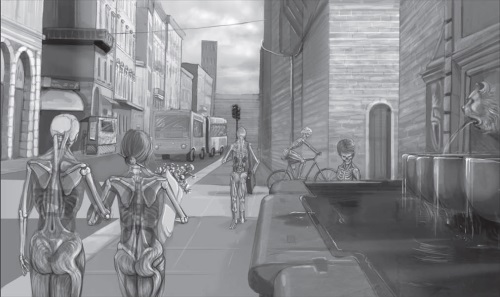
Backscatter fetishism?
Three-Star Powers
-
Postcognition
: You can see the past. With a modicum of effort,
all
of the past. Oh, and you can see the past anywhere in the world, so good job spending the extra three points to be flat-out better than
Remote Viewing
.
-
Precognition
: Exactly the same as the above, but you see the future.
-
Ghosting
: Walk through walls. Or instead, for the same cost, you can get...
-
Teleportation
: No range limit. We're told that the closer/more familiar the destination, the easier the jump. This is a filthy lie, as we will see next chapter.
Only one, but it's a doozy. Motherfucking Time Travel. Like the book says:
Aletheia posted:
No timeframe is unreachable with this power, but there are risks in journeying too far into the past or future. Travelling seconds or minutes in either direction is likely to have few ramifications, but not so with deeper Time Travel – the further one journeys, the more likely the character is to alter the existing timeline.
And as an added bonus, Time Travel includes Teleportation .
We have one final step, and luckily it's an easy one: Recording your character's starting Will. Will is a slowly-recovering pool of points you can spend, one for one, to get extra dice on your rolls. Will is equal to the star rating of your highest-rated power.
We'll dig into the mechanics of the powers next chapter, but this is getting long as hell so let's come up with powers and spend our example characters' Supplemental Points and wrap this thing up.
 Brant's power is the ability to influence reality by writing comic books. There's no clear analog there to the example powers in the book, but it sounds kind of similar to the way
Time Travel
can alter the course of events. It's not quite as versatile as
Time Travel
, though, so I'll call it a four-star power. That eats up 12 points, and with his last three points Brant's player buys Veteran Occult as an
Extracurricular Skill
.
Brant's power is the ability to influence reality by writing comic books. There's no clear analog there to the example powers in the book, but it sounds kind of similar to the way
Time Travel
can alter the course of events. It's not quite as versatile as
Time Travel
, though, so I'll call it a four-star power. That eats up 12 points, and with his last three points Brant's player buys Veteran Occult as an
Extracurricular Skill
.
Brant Harristown
Motivation : make contact with GALGOMETH
Attributes : Fitness 2 (wiry bastard), Awareness 1 (Zen-like), Personality 3 (magnetic), and Reason 2 (non-linear)
Occupation & Secondary Skills : Veteran Weird Fiction Writer, Veteran Occult, Rookie Fighting
Power : Comic book-based reality manipulation
Will : 4
 Albert, being an antisocial recluse, is very hard to pin down for things like interviews. That's because he can
Ghost
through walls. Wanting to differentiate himself from Brant, his player opts to spend his last three points on a secondary occupation of "wizard." Sadly, it's only at Rookie level.
Albert, being an antisocial recluse, is very hard to pin down for things like interviews. That's because he can
Ghost
through walls. Wanting to differentiate himself from Brant, his player opts to spend his last three points on a secondary occupation of "wizard." Sadly, it's only at Rookie level.
Albert Stoor
Motivation : take the piss out of Harriston
Attributes : Fitness 1 (Beard), Awareness 2 (Beeeeeeard), Personality 1 (BEEEAAAAARD!) and Reason 4 (Son of Beard)
Occupation & Secondary Skills : Veteran Weird Fiction Writer, Rookie Wizard, Rookie Fighting
Power : Ghosting
Will : 4
 Georgie sees ghosts. She describes it as psychometry with an auditory-visual synesthetic component, and it's triggered by any strong emotional impression, but 'she sees ghosts' is less of a brain-ful. That sounds like a combination of
Presque vu
and
Postcognition
to me. That's ten points, and her last five will go toward buying up one more rank each of
Fitness
and
Reason
, and adding a
Descriptor
to her
Reason
.
Georgie sees ghosts. She describes it as psychometry with an auditory-visual synesthetic component, and it's triggered by any strong emotional impression, but 'she sees ghosts' is less of a brain-ful. That sounds like a combination of
Presque vu
and
Postcognition
to me. That's ten points, and her last five will go toward buying up one more rank each of
Fitness
and
Reason
, and adding a
Descriptor
to her
Reason
.
Georgie Hicks
Motivation : understand the big picture
Attributes : Fitness 2 (tough), Awareness 3 (detail-oriented), Personality 1 (dizzying), and Reason 4 (analytical, font of obscure knowledge)
Occupation & Secondary Skills : Rookie Anthropologist, Rookie Fighting
Power : Presque vu, Postcognition
Will : 3
 Lister also sees dead people. Except what he sees isn't ghosts or whatever, he sees people around him as they're going to look at the moment of their deaths. He's effectively precognitive, he just doesn't know how to fully harness it yet. That's nine points, and his remaining six will go toward Rookie Music as an
Extracurricular Skill
and bumping his Fitness and Awareness each to 4. Finally, since "Survivalist" covers fighting, his player swaps his free Rookie Fighting for Rookie Computer Use instead.
Lister also sees dead people. Except what he sees isn't ghosts or whatever, he sees people around him as they're going to look at the moment of their deaths. He's effectively precognitive, he just doesn't know how to fully harness it yet. That's nine points, and his remaining six will go toward Rookie Music as an
Extracurricular Skill
and bumping his Fitness and Awareness each to 4. Finally, since "Survivalist" covers fighting, his player swaps his free Rookie Fighting for Rookie Computer Use instead.
Lister Shroud
Motivation : find my sister's killer
Attributes : Fitness 4 (tireless), Awareness 4 (ears like a bat), Personality 1 (unfailingly polite), and Reason 1 (practical)
Occupation & Secondary Skills : Rookie Survivalist, Rookie Singing, Rookie Computer Use
Power : Precognition
Will : 3
 Father Del's ability to see people's most recent sin is pretty clearly
Postcognition
. That leaves him another 6 points to spend, so his player chooses Professional Research as an
Extracurricular Skill
and a point of
Reason
.
Father Del's ability to see people's most recent sin is pretty clearly
Postcognition
. That leaves him another 6 points to spend, so his player chooses Professional Research as an
Extracurricular Skill
and a point of
Reason
.
Father Delmont Skirt
Motivation : make some kind of peace with my abilities
Attributes : Fitness 1 (portly), Awareness 5 (insightful), Reason 2 (erudite), and Personality 1 (comforting)
Occupation & Secondary Skills : Professional Priest, Professional Computer Use
Power : Postcognition
Will : 3
 The Custodian is everywhere. He is allwhen. He is omnipresent, and he is watching you.
The Custodian is everywhere. He is allwhen. He is omnipresent, and he is watching you.
The Custodian
Motivation :

Attributes : Fitness 2 (fit), Awareness 2 (aware), Personality 2 (personal), and Reason 2 (reasonable)
Occupation & Secondary Skills : Veteran Janitor, Professional Stealth, Rookie Fighting
Power : Time Travel
Will : 5
Thoughts So Far: I like the speed and simplicity of character generation, but some of the power rules seem pretty rushed. Like "walk through walls" and "teleport anywhere" being the same level. And if you're thinking Ghosting can be used for other stuff like going intangible to avoid attacks and get into unknown places you can't teleport to, nope. It literally just lets you want through solid objects. And teleport has no "you must know your destination" rule either. After seeing the powers you goons came up with, I wish there was more support for devising new powers, or at least putting interesting limitations or twists on the powers that are in there.
The game also uses different costs for Supplemental Points than the base points for different traits, which can lead to one character getting more bang for her buck than another. It's not as pronounced as, say, WoD, but it's there. Overall, while there's not a ton wrong with it, this chapter (and the next one) I feel like could have used more polish.
Next Time: Smarty stuff, fighty stuff, and earning XP for reading the GM's mind.
A Mechanical Man
Original SA post
Short update tonight, as Aletheia's actual rules are pretty basic and uncomplicated--but this is also where I'm going to get a little more reviewer-y about things. Stay tuned for some good ideas, some hilarity, and some advice on outside-the-box thinking from someone I'm pretty sure has never encountered an RPG player ever.

I covered the basics of Aletheia's mechanics in the last update, but here's a quick recap. When you want to do something, the GM sets a target number between 1 and 7. You roll a number of d6s equal to the Attribute that seems most pertinent to the action, possibly +1 die if you have an applicable Descriptor . Any dice that show 5 or 6 are victories , and if your victories equal or beat the TN, you succeed. If you have a relevant occupation or Extracurricular Skill , you get one, two, or three automatic victories. That's it for the basics, but we get some more detail on three categories of action: Fieldwork, Fighting, and Powers.
Fieldwork is the nitty-gritty, the meat of most Aletheia games: going out to someplace where weird shit went down and ascertaining the nature of said weird shit. The game breaks fieldwork into four different actions: Investigation, Interviewing, Research, and, once all else is said and done, the Hypothesis. This is where we really start to see the GUMSHOE influence on this game.
First up is investigation, the actual on-site observation. Whether it's poking around the field where a crop circle appeared or autopsying the dead guy whose face is on upside-down, you're out there poking at things, taking measurements, and doing montages set to The Crystal Method. Investigative scenes have a certain number of clues for the PCs to find, one of which is designated the vital clue. You roll Awareness for investigative actions.
Rather than resolving these scenes action-by-action, the GM sets a target number for the entire scene, equal to the number of clues to be found. Unlike other actions, you don't get to know the TN before you roll--but that's because, unlike other actions, failing to hit the TN doesn't mean failure. You just only find one clue per victory. Your first victory always gets you the vital clue , and since automatic victories apply to investigation rolls, as long as somebody has a relevant occupation or skill, you can't miss it. Other clues come in the order of whether or not your occupation/skill is relevant to the skill or not. An auto mechanic will notice spilled transmission fluid in the garage before lividity marks on a corpse, for instance. In a nice touch, the game spells out that anyone can find clues just by getting victories , but if your occupation or skill is relevant to a clue, you get some basic information about it. For instance, a paramedic who rolls two victories might find tire tracks leaving the scene or a scrap of cloth caught on a bush, but a CSI finding those same clues would have an idea of the weight and speed of the truck and what kind of fabric it is.
As a basic system, this is pretty solid and works just fine, but the game suffers from having no clear rules for having multiple characters investigating a scene. One would assume that each investigator would roll and then you'd total up their successes (after all, each one of them is going to be sharing the clues they find with each other), but with each scene typically having one to five clues, even a couple of moderately-trained investigators are going to descend on a scene like Holmesian locusts, stripping it of clues with a minimum of effort or research expenditure. Which is fine, I guess, if the meat of your game is meant to be putting the clues together more than finding them, but then why bother with all this "you might not find all the clues" rigamarole? GUMSHOE games solve the issue of group omniscence by making those extra clues things you have to buy with a finite resource pool, but here it seems like you might as well not bother with the investigation rules or else the GM needs to contrive scenarios where only one or two Society members investigate any given scene.
Interviews work almost exactly the same as investigations, except the stat you roll is Personality , and it's generally a bit easier to get the bonus from a Descriptor since you just have to play it up in the conversation. Crack jokes to set them at ease if you're funny , slap the table and make threats if you're scary , whatever. Here's where we also get our first glimpse of how we're probably supposed to handle opposed checks in this game: If the witness is hostile or uncooperative, you first have to roll a number of Victories equal to their Personality to get them to open up (or, presumably, do something in-game that makes them want to talk). Any victories beyond that give you your actual clues. Seems like that's a good way to handle other kinds of opposed actions like chase scenes or sneaking up on somebody, but it's only presented in the context of cracking stubborn witnesses.
Research is just straight-up information gathering. Sometimes it's used to give context to clues you find, sometimes it's used to figure out who to talk to or where to go next, but it's distinguished from investigation by being conducted away from the action, in a lab, library, or the like. Unsurprisingly, Reason is the key to research. Unlike investigation or interviewing, research is treated pretty much as a normal action, with the TN indicating the difficulty of finding the information at all. The only wrinkle is that you can drop the TN by 1 if you're conducting the research using a source that's especially appropriate to the information you're looking for. Researching a small town's history at the local newspaper archive, researching pretty much anything paranormal at the Hepta Sophistai library, etc. We're told in a sidebar that researching the pages of the Usher Codex is a bit of a special case; the GM gets more information on that in Chapter Eight.
Finally, once you've wrapped up an investigation and called it a day, it's time for the players sit around for a bit and kibitz about what happened, summarizing the events, collating all the evidence and developing as clear a picture of the phenomenon as they can. Once everybody's in agreement, they present it to the GM. If they got everything right, huzzah! Everybody gets 5 XP. If, however, the hypothesis is totally wrong or only partly correct, everybody rolls Reason . One, two, or three victories gets you 1, 2, or 3 XP, and the GM will correct some or all of the errors in your hypothesis depending on the victories rolled. If you fail the roll altogether, too bad, so sad, you get nothing. The GM is, however, encouraged to give out 1 XP regardless if the hypothesis is at least partially correct.
I kind of like the idea of the hypothesis round--it's a good way to keep players on the slow, steady track of discovery the game is aiming for and prevent them from getting too entrenched in their own (incorrect) ideas about the setting. In a looser game I'd prefer a rule about adapting the setting to the player's idea, but since Aletheia is so tightly married to its setting and metaphysics I think this works well. I'm far less sanguine about players getting different amounts of XP based on how lucky they are with a dice roll (especially since we're explicitly told that you can't spend Will on this roll). Without really strong advice on how much leeway to give players in ruling their hypothesis "correct" or not, it also has the potential to descend into pixel bitchy, mother-may-I bullshit. Unfortunately, there's no such advice in the book. Hope your GM's not the "well, actually the UFO was from Tau Ceti III , not Tau Ceti IV
 " type.
" type.
Anyway, on to Fighting. Aletheia is...not a combat focused game. The combat rules are very, very basic, but also have the potential to be hilariously lethal. First off, the basics: Initiative is 1d6 + Fitness (the only roll in the game that doesn't use the normal system), with some modifiers for catching people by surprise or having a Descriptor about being really fast.
Hand-to-hand combat is a Fitness roll, and has a TN of the other guy's Fitness. Damage is the total victories scored, plus a bit extra if you have a weapon. If you've got a Descriptor like brawny that might help with dishing out pain, roll a die: if you get a victory, deal one extra damage.
Shooting dudes is a little different. It's still a Fitness roll, but since "no human can dodge a bullet," the TN is 1. Adverse factors like range, darkness, movement, etc. can push that TN up. Firearms damage is the number of victories you rolled times 4 for pistols and single-shot rifles, x5 for shotguns or automatic weapons. Oh, and since it wasn't mentioned in Chapter Four, all characters have 20 hit points.
A couple things with this system: First off, occupations and skills work normally on combat rolls, which means even a moderately combat-built character (Professional occupation/skill, 3 Fitness and relevant Descriptor ) has a pretty good chance of guaranteeing at least 3-4 successes per roll. In hand-to-hand that's not too bad, but when the guns come out it's really easy to get into absurd damage numbers. The game does provide a pressure valve for this situation: when somebody lands a hit on you, you can spend 1 Will to reduce the damage to only one point--which, really, should be your sign to get the hell out of Dodge.
Now, that's pretty nasty, but you can argue that in a game that's nominally about professorial types delving into the MYSTERIES OF THE UNKNOWN, a trained soldier with an automatic rifle should be terrifying, but the line between "moderate damage" and "OH GOD HOW CAN IT HURT THIS MUCH" is really thin. Oh, and add to that the fact that damage is based on total victories rolled, not victories in excess of the TN, and your damage becomes very spiky. Gunfights in adverse conditions especially turn into Marco Polo with bazookas--either you take no damage at all or you're pretty much down in one hit. Mercifully, 0 hp doesn't mean "dead," just "knocked out" or "in need of hospital care within the next half hour" depending on the lethality of the weapon.
That's about it for fighting. We get a brief sidebar about falling damage, another about called shots, and rules for healing damage that are nothing we haven't seen a million times before. Called shots let you trade a +1 to your TN for either an instant knockout in hand-to-hand fighting or +5 damage in a gunfight. As long as you've got at least one or two automatic victories you should pretty much always be called-shottin'.
Last up in this section is powers. You always roll Awareness for powers, and you never get to add Descriptos or occupations to the roll. We're told that target numbers work differently for all powers, which is... not really true. With the exception of the powers that deal with time, all the powers only require one victory to use. We're also told that the GM should make all power rolls and conceal the results from the players. Because apparently you might not know if your roll to teleport to Kathmandu succeeded or not? Seriously, presque vu and deja visite are the only ones of these powers where the difference between success and failure isn't immediately obvious. Presque vu just returns nothing (which could mean the power failed or just that the thing you're scanning isn't important), while deja visite lets the GM be a dick and lead you on a wild goose chase for a while.
I'm going to skip over most of the power descriptions because most of them boil down to "there are no practical limits to this power." A few specific exceptions:
-
Presque vu
only reveals that an event or object is somehow significant, it doesn't tell you how.
-
If you fail to use any of the clairvoyant powers, you can't try again on the same subject until you spend 1
Will
.
-
Remember how last chapter
teleport
said that the farther and less familiar the destination, the harder it is? Yeah, no. The
target number
of
teleport
is always 1, and all you have to do is think about a location. No direct experience or line of sight needed.
-
The time-based powers have a sliding TN based on how far you're aiming to go. TN 1 gets you up to a week forward or backward, TN 3 gets you up to a century, and at TN 5 the entire space-time continuum is open to you.
-
We get this really cool sidebar about dealing with the time-based powers:
Aletheia posted:
THE OBSERVER EFFECT
In quantum physics, if an event is unobserved, it exists in all possible states simultaneously. It is not until the event is observed that one state is chosen over another. Phrased more simply, the act of observation changes the phenomenon being observed. This has a very real application in Aletheia .
When a character uses Postcognition or Precognition, the act of observation changes the past or future. Most times, the changes are so subtle and minor that no one will ever notice them. However, the farther and longer one gazes across time, the more likely noticeable changes will occur. Therefore, characters should be cautious of how far and how long they look into the past or future. By doing so, they are actually altering what has occurred or will yet come to pass.

And we close out the chapter with a little section about "using powers creatively" that's just... oh God, it's just adorable.
Using Powers Creatively posted:
Beyond their basic applications, there are myriad ways for powers to be used creatively by players. The following examples are merely a sampling of what is possible.
Surprise
The element of surprise can be valuable in certain situations, most notably during a fi ght (see page 56). With Postcognition, characters can know their opponents’ plans as they are formulating them. With Precognition, a character can see how events will unfold and alter them to his or her benefit. With Ghosting, Teleportation, and Time Travel, a character can appear from nowhere and get the jump on an unsuspecting foe.
Dodging An Attack
If an opponent pulls out a gun, and there’s no available cover, a character can use Time Travel, Teleportation, or Ghosting to get out of the way before the shot is fired. To do so, the character must fi rst make an Awareness roll (TN of 1) to react quickly enough to the situation. If this roll is successful, the character rolls to activate the power as normal.
Changing The Past
Characters with Time Travel and Precognition have the ability to alter past or future events. If a friend is murdered, for example, a character with Time Travel can journey into the past and stop the crime. A character with Precognition might see the murder happening in advance and make sure it never comes to pass. Using powers in this manner is fine. However, players will need to keep in mind that there may be unforeseen ramifications to doing so.
Seriously, you just got through telling us that we can teleport anywhere in the universe at will, travel to the beginning of the cosmos with a modicum of difficulty, and/or see what's happening anywhere in the world whenever we want, and the most creative uses you can suggest are surprising people, dodging attacks, and the plot of every time travel movie ever? Go read Steven Jay Gould's Jumper to see some of the truly ridiculous stuff you can pull off when you can teleport at will. If you can get past the weird-ass prose, read C°ntinuum: roleplaying in The Yet for a thousand and one clever time travel tricks. Hell, run two sessions of this game and I bet your players will come up with better stuff than this.
Anyways, that's it for Chapter Five. Nothing ridiculously broken, but it feels like the only people who really developed or proofread it were the people who designed the game and knew how it was "supposed" to work. Lots of places where you can infer rules that probably should have been clearly spelled out, some cases where the intent isn't that clear. It works pretty well for simple, basic actions, but I see lots of potential for edge cases and unclear situations cropping up in actual play.
Next time: A Child's Garden of Weird-Ass Shit.
Usher's Ultimate Truth (Cleric, 6)
Original SA post
In his dotage, Cyclops turns to--what? We've already made a joke about Marvel characters who wear red glasses? Well, shit.
Quick update tonight to clear the decks for the full-on insanity of Chapter Seven this weekend.

Chapter Six is the last of the player-centric chapters, and it's the first (and only) chapter in the book that has an in-character voice. The chapter opens with an e-mail from one Judith Seales to tl_chastain@yahoo.com . Judith is a member of the Society, and after telling Chastain that the Society is on the cusp of discovering Usher's ultimate truth, she says she's sending him all the Society's old case files, along with some general best-practices for the investigation of flying saucers and weird energy vortices. It wraps up with this rather mysterious statement:
Judith Seales posted:
I wish I could share more with you Terrance, as you’ve been a good friend these years, but we both know that is impossible. Like Jericho before us, only a select few can understand or undertake this voyage. However, we are optimistic that, one day, humanity will be able to make the pilgrimage as well.

Anyway, I'd make fun of Chastain for using a Yahoo address, but the e-mail is dated December 21, 1999, so I guess that's historical accuracy. (December 1999, you'll remember, is when the first incarnation of the Society vanished forever.)
What follows is some "babby's first investigative game" player advice: Take notes on everything, collect evidence, gather witnesses, and for God's sake document everything. All fairly obvious, but good for kicking players out of a "kick in the door and stab things" mindset. Nothing really crazy or noteworthy here.
Next, oddly tucked under its own heading between the investigation advice and the sample case files is a little section about "Vile Vortices." Coined by Ivan T. Sanderson , an early follower of Charles Fort, these vortices are natural places where air and water currents create odd zones of paranormal energy. Examples include the Bermuda Triangle and Lake Baikal in northern Mongolia. Vile Vortices can be places of healing or places of great violence, but they're also frequently linked to the phenomena the Society investigates.
Now we get a whole bunch of Sample Case Files. Actually, that's a bit of a misnomer, since almost all of them are more a broad classification of weird phenomena than specific adventure seeds. Each includes applicable cross-references to consult for more information, a location where the phenomenon has been observed, a number of verified occurrences, and typical numbers of witnesses.
If you're starting to think this feels as much like an adventure-building toolkit for GMs as a setting resource for players, you're not wrong. Some highlights:
-
Virgin births are incredibly rare and understandably hard to verify (since really the "virgin" part is a misnomer; we're talking here about human parthenogenesis, a pregnancy without male fertilization of the female egg). The only potentially valid claim the Society investigated happened in rural Indiana in 1982, in which a woman named Sarah Jessup gave birth to a son. Both Jessup and her daughter claim that the boy was born nine months after a mysterious alien encounter, and that Sarah was in fact post-menopausal at the time. I guess that's why it was considered potentially valid, but since medical records are spotty-to-nonexistent it's never been conclusively settled. It
is
noted that nearly all of the virgin birth stories featured in myth and religion involve a son, though.
-
"Unusual precipitation" is weird, varied, and usually bullshit, but small animals plummet from the sky often enough to warrant their own entry.
-
Spontaneous Human Combustion typically features "one witness, a handful of survivors." Get it? Because

-
Agriglyphs, better known as crop circles, are usually the result of bored English kids.
-
This:
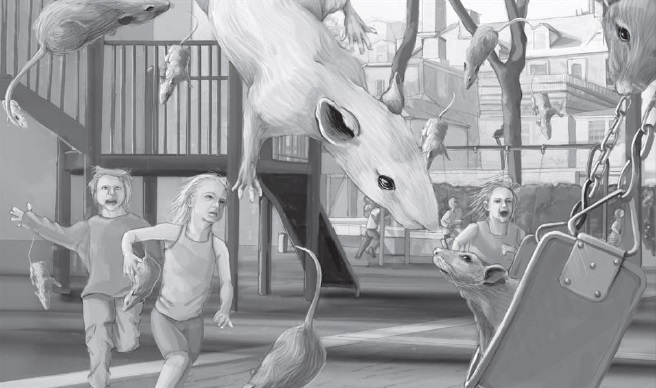
I'm... not sure whether to be afraid of the falling rats or those horrifying nightmare children.
-
Back in the early 90s, a psychiatrist named
John Mack
commenced a decade-long study of people who reported alien abduction phenomena. He found that many reported a significant change in spiritual outlook and a general feeling of increased connection with the universe. He likened these changes to those experienced by ancient hunter-gatherers during "vision quests."
-
Likely drawing from a lot of the same inspirational sources as
Changeling: The Lost
,
Aletheia
posits that "alien abductions" are just a modern take on much, much older phenomena like faerie abduction or the Biblical tales of prophets taken up by the angels to speak with God.
-
The Society pays news collection agencies to follow reports of UFOs because there are so damn many of them. This usually works out about as well as you'd expect.
-
Just about every near-death experience the Society ever investigated turned up the same "peace and love, white light and dead relatives" reports. Except this one dude, Tom Vargt, who reported experiencing icy cold and intense terror, and conversed with a being of pure darkness. Vargt had no criminal record or history of antisocial behavior, and was in fact a devout churchgoer and frequent giver to charity. Spooooooky.
-
Ghosts are classified as Class A (full manifestation with environmental interaction) to Class M (sensory effects only). This deprives me of the ability to refer to ghosts as a Class 5 Full-Roaming Vapor and is therefore objectively wrong.

-
The town of Taos, NM has a hum. Nobody seems to know what it is, and it doesn't seem to
do
anything, but any Society member who goes to Taos can hear it. Hmmm...
Hmmm.GimpInBlack posted:

Julio's
This door opens onto a massive junkyard outside Taos, New Mexico that seems to have a bit of everything. The owner (whose name is actually Julius) claims that "if it isn't here, it wasn't made." Nobody's proved him wrong yet.
-
With 837 reported cases of psychic surgery, the Society's only witnessed three. Two were obvious hoaxes, the third cured a dude's cancer.
-
Phenomena included but not really interesting enough to pull a comment from:
EVP
,
Automatic Writing[/url, [url=http://en.wikipedia.org/wiki/Missing_time]Missing Time
, and
Folie à Deux
. All offer some variation on "a lot of these cases are easily faked, but some appear to be real!
The chapter concludes with an e-mail response from Terrance Chastain to Judith Seales. It seems he received the shipment that supposedly had all the Society's casefiles, but the boxes were empty! Dun dun DUN! Obviously in her excitement to trip the light fantastic, Judith forgot to actually fill the boxes before mailing them. Psychic vision-questers, amirite? Terrance is also getting a little frustrated at being kept in the dark about all this paranormal stuff and the details of the society's findings, but he "knows his place" in the scheme of things. Come on, 7DS, throw the poor guy an authenticated Patterson-Gimlin Film or something.
Thoughts so far: Not a ton to say here. It's a fine chapter for getting players into the mindset of the particular kinds of Forteana this game is going to feature, and I like that each entry addresses some of the common skeptical explanations for these phenomena and making it clear that yeah, a lot of them are bullshit. It's a nice change from the breathless "but it's all truuuuuuuuuuuuuuue!" you get from a lot of these games. It's a fairly diverse spread, but with three entries explicitly about aliens/UFOs and a few more strongly linked to UFO activity, it's pretty clear who the star players are. Or so we think, at least.
Next time:

The Book Of Revelation. Singular. Assholes.
Original SA post
Does anybody else smell blue?
Strap yourselves in, boys and girls, because this train's about to pull into Crazy Town Station. It's time for....

In the penultimate chapter of the book (not counting the sample adventure), we finally learn what the hell is going on. All the weird shit going on in Aletheia --the psychic powers, the mysterious fates of Jericho Usher and the previous incarnations of the Seven Dogs Society, the doorways in the Annex, and of course the Usher Codex--are shadows of a much larger truth. That truth is what we're about to discuss. Bieerdo put it best back on page 5 of this thread:
Bieeardo posted:
And speaking of without actually speaking of, god damn does this shit get late Seventies Disney, fast.
Yeah.
 Spoilers ahead!
Everything past this point is going to spoil the central mystery of
Aletheia
. I'm not going to spoiler tag stuff because goddamn that would be annoying for all of us, so if you think you might want to play
Aletheia
and come at it fresh, now would be the time to stop reading this F&F.
Spoilers ahead!
Everything past this point is going to spoil the central mystery of
Aletheia
. I'm not going to spoiler tag stuff because goddamn that would be annoying for all of us, so if you think you might want to play
Aletheia
and come at it fresh, now would be the time to stop reading this F&F.

So, let's talk about the universe. Human beings perceive a four-dimensional universe: three physical dimensions, plus time. We tend to think that's all there is to existence, but boy howdy are we wrong. See, our "reality" is just a thin, four dimensional membrans sitting within a much larger, multidimensional space, like the ribbon running through the middle of a marble. This higher-dimensional space is the reality Jericho Usher dubbed the "Otherverse," and it's not empty. Just as our universe exists entirely in a four-dimensional membrane suspended within the Otherverse, other membranes of varying dimensionality float somewhere out there, each another universe. Some of them are very like our own, others are wholly alien.
While we (and everything we perceive as being part of our "reality") are trapped within our own membrane, and the inhabitants of other universes are trapped in their own, a class of beings called "ultraterrestrials" live within the higher dimensions of the Otherverse itself. They can move freely through its substance, and sometimes a part of their manifold existence intersects with the membrane of our universe. Humans are naturally quite unable to understand these intersections, and have variously put them down to visitations from angels, demons, gods, or extraterrestrials.
The mingling of terrestrial and ultraterrestrial has, at various points throughout history, resulted in the creation of hybrid life forms, called the Nephilim. That's right, from advanced high-energy physics we're taking a hard left into Biblical apocrypha. These Nephilim are human, but they're only loosely bound to the four-dimensional universe. If you imagine
We'll take a short break from magic space-people to talk about string theory and the music of the sheres. Briefly, string theory posits that the smallest building blocks of matter, rather than being point-like (i.e. our common conception of atoms), have a finite length and behave like the strings of a violin. That is to say, they have a specific vibrational frequency.
In order for the mathematical models of this theory to make sense, though, the universe has to have more than four dimensions: most models posit ten or eleven. Since we obviously don't experience that many dimensions in our day to day life, two different theories have arisen to explain the apparent inconsistency. Either the extra dimensions are so small as to be effectively imperceptible at our scale (much in the way a sheet of paper is technically a three-dimensional object, but its thickness is so minuscule that we tend to think of it as 2D), or the extra dimensions are inconceivably vast and our 4D universe is a subset of higher-dimensional space. That's the model Aletheia posits.
In this model, in addition to one-dimensional strings making up the basics of matter, the universe contains multi-dimensional surfaces called branes. Strings are classed as either "open" (strings with two distinct endpoints, like a length of thread) or "closed" (a self-contained loop, like a rubber band). Both can vibrate, but the open strings have to be anchored to something--i.e. the four-dimensional membrane of our universe. In other words, they can only move along that comparatively tiny surface, perceiving the universe as we know it as all that exists. Closed strings, on the other hand, are self-contained and thus can move freely throughout the higher-dimensional superstructure of the world.
Ultraterrestrials and their Nephilim offspring, then, are either composed entirely of closed strings or possess the psychic ability to close certain strings in certain ways. That's why, at their core, all the psychic powers are about perceiving or manipulating spacetime in some way.
Still with me? Good. Let's talk about God. Oh yeah, there's a God. Before the Big Bang introduced existence into things, the entire Otherverse was a perfect, perfectly symmetrical, perfectly uniform hypersphere of 11-dimesional... stuff. That hypersphere was also God. Being a hypersphere of 11-dimensional stuff was pretty boring, so God allowed differentiation to break up the symmetry of its form. Branes formed within the Otherverse, and with them came different forms of life, both those bound to the membranes of individual universes and those who could move freely through the whole structure. Then one day God noticed a couple of life forms stuck on one little three-dimensional planet stuck in one little four-dimensional membrane. These life forms were called humans, and God was fascinated by the fact that such limited beings had developed self-awareness. So he made them the Garden of Eden, and he made himself some ultraterrestrials: beings that were like humans, but not limited to traveling along the membrane.
Everything was cool for a while, but the humans, when they saw the ultraterrestrials, started to get worried that they wouldn't be God's favorite little children any more. After all, these guys were like them, but not restricted to four paltry dimensions of existence. They started to demand that the ultraterrestrials teach them to move in higher dimensional space and be like unto God. God's response, on realizing that humans would never grows or evolve as long as they were stuck in their perfect stasis of Eden, was to twist their perception of the fourth dimension: time. From then on, every human being would have no choice but to march endlessly forward in one direction of time. They would age and die, and would perceive the decay and death of everything around them. (Yes, the first time you learn that humanity hadn't been experiencing linear time up till now is when the book tells you God took it away.
 ) God then stepped away from the membrane and left the oversight of humanity to a group of ultraterrestrials called the Grigori.
) God then stepped away from the membrane and left the oversight of humanity to a group of ultraterrestrials called the Grigori.
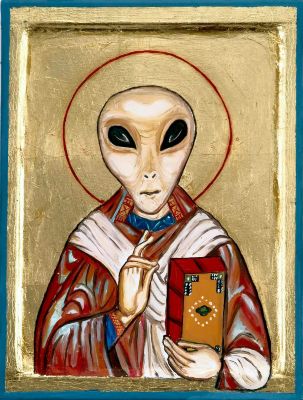
Praise Blorgnax.
Well, freaky alien messiahs or not, I think everybody here knows what happened next. The Grigori got a little too friendly with the humans, ruled over them as god-kings, and commenced to boning. God talked to a human named Enoch, came to understand how much being a human ruled over by 11-dimensional monsters sucked, and created a huge flood to wipe the Grigori cults and the Nephilim out of the universe. Then he snatched up all the Grigori, split open their strings, and tied them to a one-dimensional prison-brane somewhere in the Otherverse. Problem is, it's pretty hard to wipe out beings who can unmoor themselves from time with a single flood, and so the Nephilim were able to use their powers to walk outside time until the floodwaters receded. Being part-human, though, they didn't have an easy time of it. Some of them reappeared just a few weeks after the flood, others trickled back into time years, centuries, even millennia later. Once they figured out that miraculous abilities were more likely to get them stoned to death than worshipped as god-kings, they blended into human society and started passing down their angelic genes. For all their power, Nephilim are still human, so eventually they all grew old and died, and their abilities were scattered across the generations.
Enter Jericho Usher. Remember all those crazy hallucinations and sensations of being on the cusp of something important? Yeah, that was Jericho developing his Nephilim powers. And when he took up drinking ayahuasca tea and vanishing for months at a time? He was exploring the Otherverse and conversing with a spaceman angel named Lam. From Lam he learned two things: that other human/ultraterrestrial hybrids existed in the world, and that Enoch, who was 100% pure homo sapiens , had learned from God how to unmoor himself from the membrane of the universe. Usher concluded that humanity's birthright was free, full-dimensional existence and oneness with God, and that the best people to lead the human race to that destiny would be the descendants of the Nephilim. He wrote the Usher Codex to serve as a road map to enlightenment, built the Annex to prove the multidimensionality of the Otherverse, and left Terrance Chastain the genealogies of those with Nephilim blood. The groundwork laid, Jericho Usher left the world to walk with God.
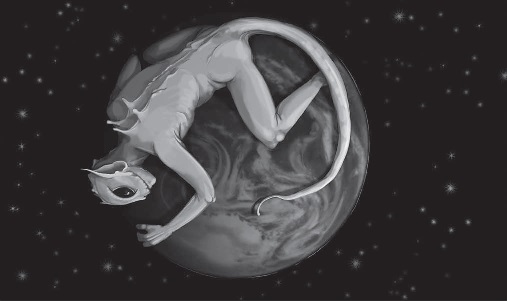
...Kay then.
So how do people disconnect themselves from the membrane? Turns out you need DMT. N, N-dimethyltryptamine, to use its full name, is produced in small quantities in the human brain by the pineal gland. Certain experiences like meditation, sensory deprivation, and death increase production. It can also be found in various entheogenic drugs, like ayahuasca. DMT closes some of the strings that make up our existence--the normal amounts produced by the pineal gland are just enough to give us self-awareness, a "soul" if you like. Larger doses can partly or wholly unmoor our perception from the membrane. If you're a Nephilim, it also helps you master the weird geometries of the Otherverse and, eventually, physically leave the membrane behind.
Oh yeah, and unbeknownst to modern posychiatric medicine (but knownst to us), all psychiatric problems are caused by DMT imbalances. Too much DMT leads to a soul that's not connected closely enough to the body, which leads to feelings of dissociation and otherness. Too little and the soul is too closely bound to the body; this leads to lack of empathy and psychopathy.
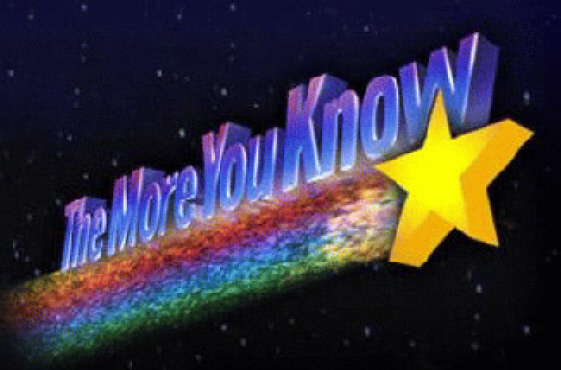
So, what's the Otherverse like? Frankly, it's fucking weird, and even Nephilim are still four-dimensional beings at their core, so any attempt to really describe it is going to boil down to metaphors and vision quests. Between the membrane of our universe and the Otherverse proper is the Threshold: a multi-layered buffer that insulates our universe from the rest of creation. The nearest layer is dubbed the Glass Chrysanthemum: it appears as a vast, multilayered crystal dome that shines with light and hums with a music at once familiar and wholly unlike any human music. It blocks progress deeper into the Threshold until you can learn to orient yourself in six-dimensional space, at which point you can pass into the dome and discover the seven cities built on its inner surface. These cities are higher-dimensional reflections of the entirety of human civilization, and as your perspective shifts they might appear as anything from ancient Ur to modern Times Square. The cities are completely empty, but written in glowing, six-dimensional glyphs on their walls are the equations that underlie the entirety of our universe.
And that's just the first layer.
Once you've navigated through all seven cities, you become aware of a seventh direction of travel orthogonal to the Glass Chrysanthemum's six dimensions. Taking this route takes you to the glass shore of a vast, stormy sea, called the Labyrinth. You can walk on the surface of the sea, but no power in the Otherverse lets you dive beneath the surface, because that's the Way Out. Humans, even Nephilim, don't yet have the understanding to pass beyond of their own free will yet. Jericho Usher and the prophet Enoch are the only ones who've managed it. Fortunately, someone anticipated the problem: Standing on the shore of the Labyrinth are six enormous statues that appear to combine Egyptian and Mesoamerican styles, and... you know what, I'm just going to quote this part, because goddamn.
Aletheia posted:
Six stand a silent vigil, though travelers will sense that a seventh was at one time present. These statues can be entered through doors at the base of the legs, if oriented in the proper direction. Inside each colossus are seven rooms, each with a single chair and a set of baroque controls. The fi rst room is spherical, carved from a stone of coral red, with a raised platform to hold the chair and controls, and is located near the lowest point on the torso, at the base of the spine. The next one, further up, resides in the lower belly and is an icosahedral crystal of fi ery orange. Farther along, halfway near the solar plexus of the statue, is a radiant room of bright yellow and shaped as a dodecahedron. Above this, in the center of the chest is the fourth room, an emerald chamber with eight facets, with a dais in the center for controls. The fifth room is a simple cube of bright blue located in the throat of the statue. Centered in the middle of the forehead, forming a triangle with the solemn eyes of the colossus, is a tetrahedral crystal of deep indigo. This room allows the person inside to see through one of the facets to the exterior of the statue, and is the only such area where external observation is possible. The final room sits just beneath the crown of the head, and is another sphere of the richest purple.
Each room sits orthogonal in one direction to every other chamber, meaning the statues themselves are seven-dimensional structures. Although each room appears to be separated from another by vast internal differences, the rooms are actually superimposed on one another in a higher dimension. Traveling the path that runs the center of the statue and connects the rooms requires changing orientation as one moves further up. However, when seven are seated, one to each chamber, they can use the controls to cause the colossus to move. This requires the coordination of all seven pilots, which is simple once they realize the proximity they have in a higher dimension. These colossi were designed to be the vehicles for those humans who managed to penetrate the puzzles of the Threshold. As seven-dimensional structures, the colossi can permeate the fl uid of the maelstrom to descend in its depths – the sea being the surface skin of the Otherverse beyond. The original Seven Dogs Society mastered the secrets of the colossi and took control of the now missing statue. The remaining six sentinels await the coming of another set of seven to leave the membrane and to sail on to the Creator.
That's right, kids, take lots of drugs, leave the Universe behind, and pilot Enlightenment Voltron out into the cosmos to meet Alien Jesus. Where's my
 for
Aletheia
?
for
Aletheia
?
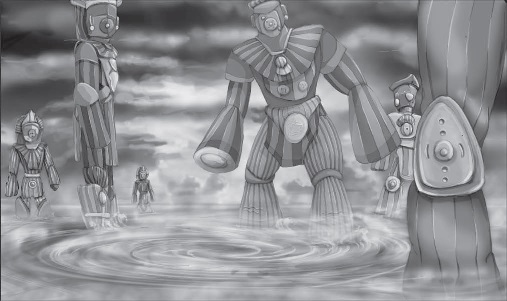
And I'll form the chakra of Sahasrara, within which there is neither subject nor object!
After that particular bit of batshittery, we're going to bring it back down to earth a little. The next section revisits the anomalous phenomena from Chapter Six, this time with explanations for how they fit into the multi-dimensional reality of Aletheia . When they're legit, that is--the book flat out tells us that sometimes a UFO really is just swamp gas reflecting the light from Venus, and just because the Society investigates something weird doesn't mean it has to be paranormal. Highlight reel:
-
Agriglyphs are usually fakes, but sometimes they're the result of a higher-dimensional being or object either passing through our membrane or temporarily attaching itself to our universe.
-
Alien abduction, unsurprisingly, is typically ultraterrestrial contact. A lot of them, like Lam, are trying to help humanity achieve its destiny, but since understanding of the true nature of reality has to happen gradually, these abductions are gentle prods rather than expository infodumps. Humans tend to perceive this as bizarre medical experiments.
-
Automatic writing can be a weaker expression of DMT-induced higher-dimensional perception. Most of the time, though, it's just subconscious expression.
-
EVP is sometimes direct communication with ultraterrestrial beings. Other times it's related to "ghosts," which are really just the effects of massive DMT production at the moment of brain death. This extra DMT lets bits of the human consciousness become unstuck in time, radiating outward from the moment of death.
-
Folie a Deux can usually be blamed on Nephilim or on higher-dimensional perception.
-
The Hum is actually the multidimensional oscillations created when the first Seven Dogs Society left the universe behind. The "sound" rippled outward in time and space, and places like Taos are pockets in our four-dimensional geometry that amplify the vibration.
-
Psychic surgery is usually bullshit, but people with
Ghosting
can do the real thing.
-
Spontaneous combustion is often a messier example of the same phenomena that cause agriglyphs. Ditto some UFO sightings (but most of those are hoaxes or misattributions--ultraterrestrials don't need UFOs).
-
Remember the explanation for the Hum? That's pretty much what Vile Vortices are--places that naturally amplify higher-dimensional energy.
-
Virgin births are... well, thankfully most of them are hoaxes or mythology, but some ultraterrestrials are worried that the descendants of the Grigori are too tightly bound to the membrane thanks to generations of human DNA. So sometimes they take it on themselves to use
Ghosting
to impregnate women and make true Nephilim, who are much, much more powerful than those whose ultraterrestrial heritage is hundreds of generations back. It's sort of implied that Usher was one of these kids.
Next up we get some secrets behind the Annex and its destination. Usher built the Annex with Lam's help, primarily as a big neon "explain this , motherfucker" sign to help recruit skeptical members to the 7DS. The sites weren't chosen at random, of course: Lubaantun, for instance, was one of the sites Usher regularly pillaged to fund his operations. When you can see in 11 dimensions, it's real easy to find hidden tombs and treasure caches. Oh, and the crystal skull? It's an ultraterrestrial artifact that lets a Nephilim look directly onto the Labyrinth.
At Roanoake, the Croatoan Indians were mostly Nephilim. When the English colonists attacked these "Devil-worshipping witches," the Croatoan responded by snatching them out of the membrane and leaving them stranded in the Threshold, whereupon they went batshit crazy and mostly committed suicide. Some of them are still out there, though.
Julio's Junkyard is only significant because of the Taos Hum and its associated Vile Vortex. The junkyard owner is definitely not God.
One of the scrolls found at Qumran tells the history of how the Nephilim avoided the flood by stepping outside time, and goes on to talk about their integration into human society and their descendants. The scroll itself is believed to be stored in a secret annex under the Israel Museum.
Tunguska was the site of an escape attempt by the Grigori. They managed to create a link between their one-dimensional universe and ours, but it wasn't stable and sealed itself off quickly.
Hannah's Diner just happens to be pretty close to the site of the Sutton farm, site of the Kelly-Hopkinsville encounter in 1955.
Chambira, meanwhile, is just a convenient place to gather ayahuasca to fuel some righteous vision quests.
Next up is a quick piece on the Usher Codex. Nothing too bonkers here, you've probably figured most of it out by now: it's Usher's chronicle of how to attain enlightenment and leave the universe behind. It's all obfuscated and encoded because too much understanding too fast drives people bonkers. In fact, the mysterious fire that destroyed most of the Codex back in the 70s was caused by Lam, because the Society was figuring shit out faster than their minds would have been able to take. He also put the "lost" fifth page in the Bibliotheque National when they were ready to understand it.
Finally, we wrap up the chapter with a few supporting characters. First up is Sebastian de Villiers , a Nephilim-descendant who believes the Voice of God is telling him to hunt down other "demon spawn" and purge them from the earth. He's actually in psychic contact with the imprisoned Grigori, who think if the Nephilim are wiped out maybe they'll be forgiven and set free. Sebastian is obviously meant to be the setting's big bad--he's ruthless and insane and has a cadre of henchmen he's mentally broken by repeatedly rotating them through higher-dimensional space. Not only does the process drive them mad, it causes their bodies to become "mirrored." Open one up and his heart's on the left, for instance. Creepy. Sebastian has three new powers: Pierce the Veil, which lets him see extradimensional objects/creatures/energies, Sever The Cord of Reality, which lets him temporarily eject people into the Otherverse, and Orthogonal Rotation, which lets him rotate people on a higher dimensional axis and generally fuck them up.
Ursula Thorndike owns Thorndike Enterprises, a big multinational conglomerate. In her mid-30s, she's one of the youngest multi-billionaires on the planet thanks to her Nephilim-derived precognition. Lately she's been having weird dreams about Mt. McKinley, the Colossus of Rhodes, and a bunch of people she's never met. She's thinking it might be time for an Alaskan cruise.
Raymond Halston III is the editor of Unified Field Operations magazine, a UFO/Forteana periodical. He used to be a legit paranormal investigator, but he got fed up with all the cranks and hoaxes and started the magazine instead. Unfortunately, as submissions have dried up he's been forced to resort to fabricating sensationalist stories just to keep the magazine operating.
Beverly Saunders is an alien abductee. Taken from her home in Arizona, she was missing for days before returning with no memory of her lost time. Her marriage fell apart under accusations of cheating and mutual resentment, and after a mental breakdown and a stay in a treatment center she remembered her ultraterrestrial encounter and the experiments that were done on her. Beverly, you see, is part of the ultraterrestrial plan to create a new strain of humanity that's better equipped to leave this universe behind than the Nephilim. Unfortunately, in Beverly's case the process inflicted not-inconsiderable psychological trauma. In addition to deja visite, remote viewing, and ghosting, Bev has a new power: Projected vision, which lets her impose her own clairsentient visions on other people.
Terrance Chastain and the staff at Hepta Sophistai get a brief writeup, which I'm going to quote from:
Aletheia posted:
Though ignorant of the details of any particular investigation, the staff is fully aware of the society’s purpose, to investigate odd anomalies; they simply do not comprehend the magnitude of the society’s work. In general, the hired help views the society as a collection of eclectics indulging Chastain’s fanciful interests. That said, the staff is dedicated to serving the Seven Dogs Society and count them as friends.
Although the staff is aware of the disappearances of the previous societies, Terrance has never spoken of their fates, always brushing aside such questions. This has created considerable speculation and rumor mongering among the staff. Adding to the gossip is the western annex. The staff is forbidden from entering that section of the house, and the door leading to the annex hallway is always locked; only Terrance and the society members have keys. Over the years, this and other curiosities have prompted inquiries from the staff, though none have ever successfully pried any answers from Terrance or the society. Those of lengthy tenure no longer even bother to ask questions.
Oh God I want to run this campaign. It's like Downton Abbey except Maggie Smith is tripping balls on peyote and babbling about seventh-dimensional omni-minds and sometimes Lady Mary turns people inside out for fun.
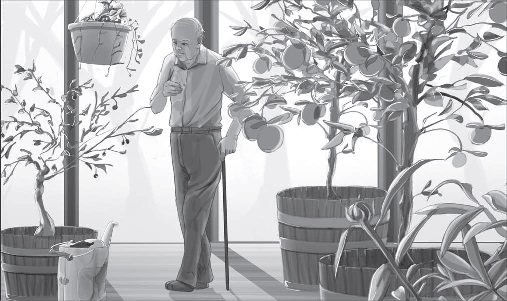
Madam takes her salvia promptly at nine.
Finally, a brief note on Societies Past doesn't really tell us anything new except to explicitly state that Sebastian de Villiers murdered the second incarnation of the Society.
And that's it for this chapter. Damn, I'm glad to have all that out there. I've got to say, for all that it's pants-on-head crazy in places, the mythology is pretty self-consistent and well-suited to gradually peeling back the layers of the mystery. The example characters aren't the most inspiring, and the later sections of the chapter tend to over-repeat certain things (I think this chapter marks about the fourth time we're reminded that Chastain is old, in poor health, and haunted by the murder of the second Society), but overall it's probably the chapter that most makes me want to run this game.
Next time: Game Mastering, or, "How to take this insanity and turn it into a story."
Space (Holy) Ghosts
Original SA post
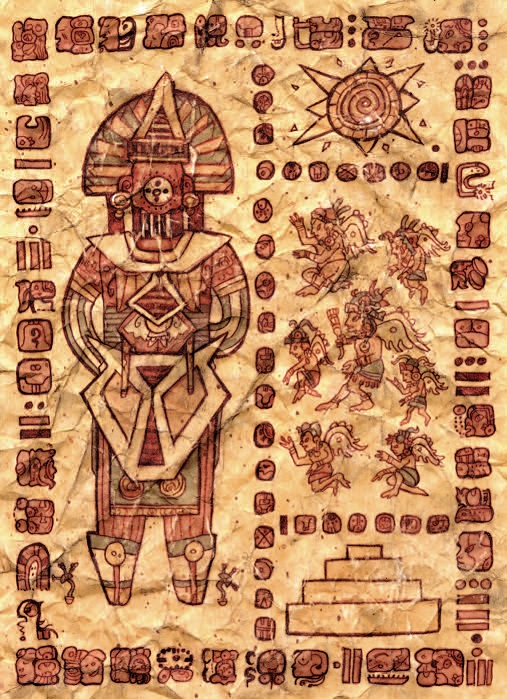
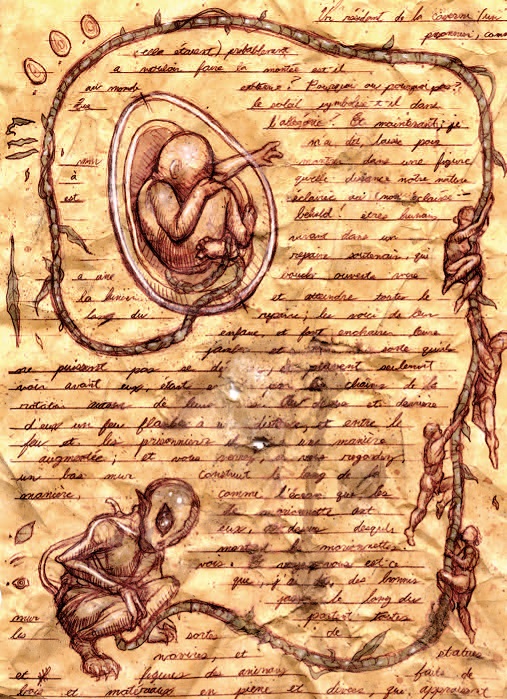
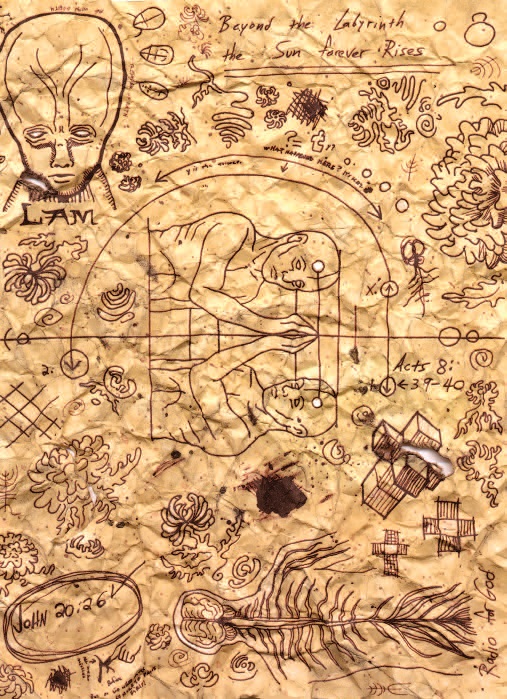
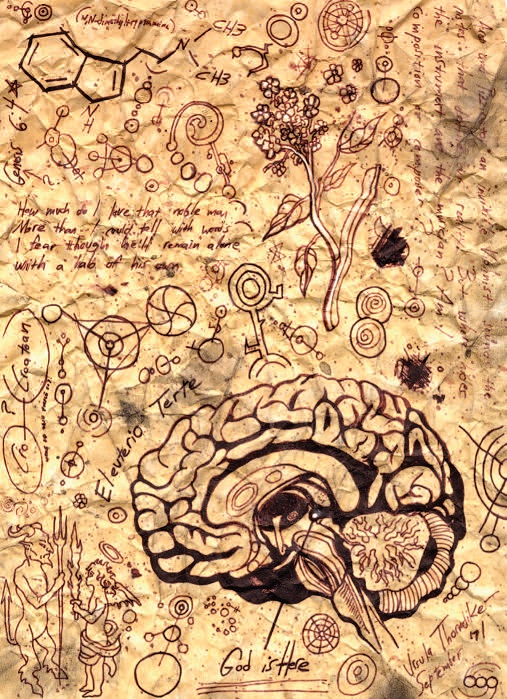
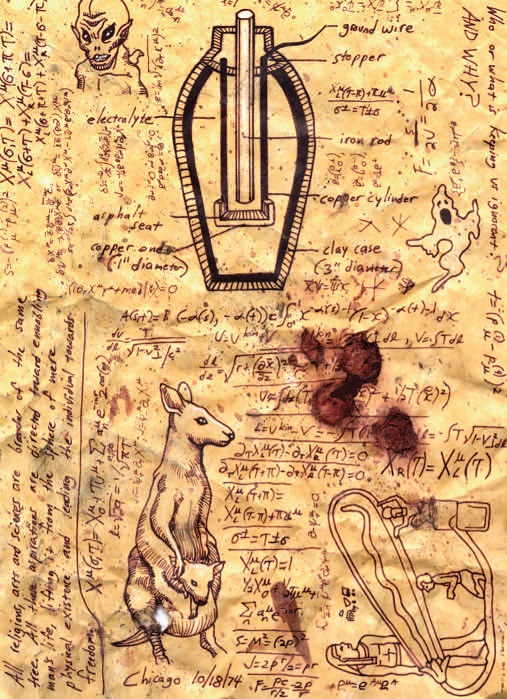
Aletheia posted:
It is up to the Gamemaster to set target numbers for identifying the references on the manuscript pages. For example, the quotes by Einstein would have a TN of 1, while other more cryptic references would have higher target numbers .

Aletheia Chapter 1 posted:
The player characters are among the seven new recruits. In all likelihood, this is the last formation of the Seven Dogs Society. Chastain is too old and establishing the society yet again would be exceedingly difficult for him.
-
Orientation: Helps you orient and adjust your perspective in higher-dimensional space. Basically required for effective use of your (limited) time when tripping out on ayahuasca and travelling the Threshold.
-
Combust: By forcing hyper-dimensional objects to intersect with the membrane at a specified point in spacetime, you can release a tremendous amount of energy in the form of heat. Pyrokinesis, yeah!
-
Hyper-dimensional bridge: Basically wormhole creation. It's a teleportation bridge kind of like the Annex portals, but this power always makes two-way bridges. Only ultraterrestrials can make one-way bridges.
